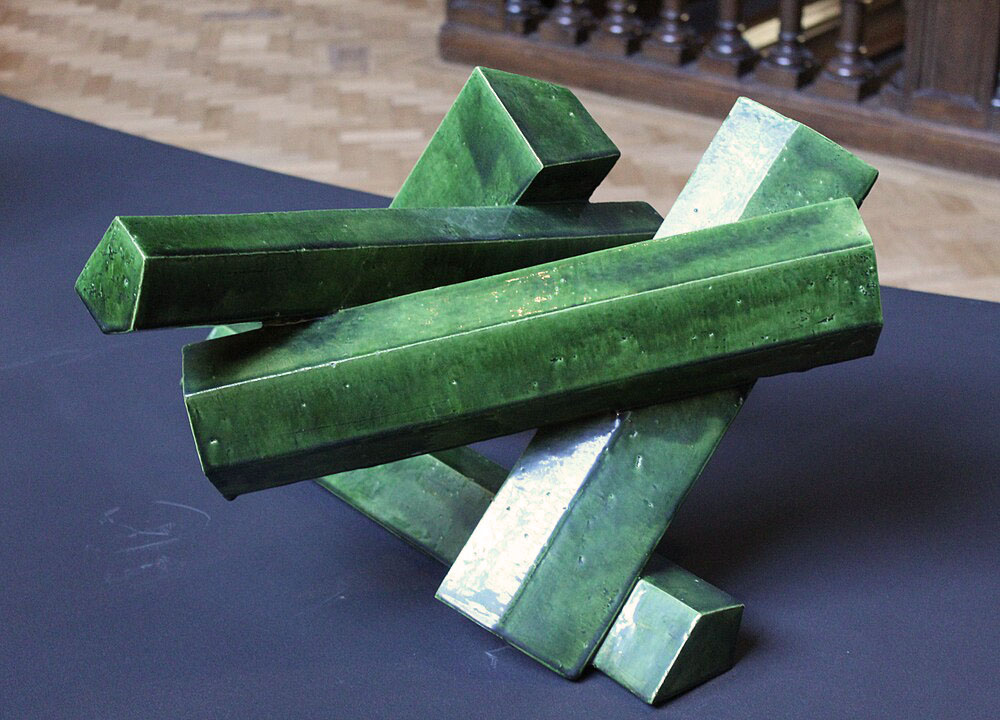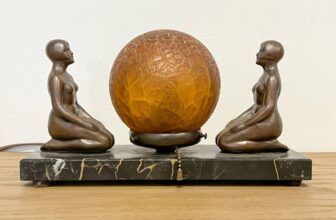
Richard Deacon’s Most Famous Sculptures
Richard Deacon is widely regarded as one of Britain’s most inventive and influential sculptors, whose career spans over four decades and whose works have redefined the possibilities of sculpture. Winner of the prestigious Turner Prize in 1987 and represented in leading museums and public spaces across the globe, Deacon is known for his ability to merge craftsmanship with conceptual depth. His sculptures, whether monumental or intimate, demonstrate a restless curiosity about form, material, and the interplay between physicality and language.
This article explores his most famous sculptures, his distinctive artistic style, the methods he uses to create his works, how much they are worth, and where you can find them today.
Who is Richard Deacon?
Born in Bangor, Wales, in 1949, Richard Deacon grew up with an early fascination for making and building. His formative years were shaped by the post-war British art scene, and he trained at some of the UK’s most notable art institutions, including Somerset College of Art, Saint Martin’s School of Art, the Royal College of Art, and the Chelsea School of Art.
Deacon emerged in the late 1970s and early 1980s as part of a generation of British sculptors who moved away from the heavy, welded steel forms associated with artists like Anthony Caro and embraced a more experimental approach to materials and fabrication. He often calls himself a “fabricator” rather than a sculptor, emphasizing the constructive, almost architectural process of his work.
What Is Richard Deacon Known For?
Richard Deacon is known for:
Inventive Use of Materials – Deacon works with wood, stainless steel, ceramics, vinyl, leather, and laminated plywood, often combining them in unconventional ways.
Complex, Organic Forms – His sculptures often twist, loop, and bulge in unexpected directions, suggesting movement and life.
Interplay Between Interior and Exterior Space – Many works feature hollow forms, openings, and interlocking elements, inviting viewers to explore them visually from multiple perspectives.
Language and Titles – Deacon’s sculpture titles are often poetic or ambiguous, hinting at narratives or metaphors without dictating a fixed interpretation.
Public Art – He has created large-scale works installed in cities across the world, engaging directly with architecture and the urban environment.
Deacon’s art straddles abstraction and metaphor, inviting both physical and intellectual engagement.
Richard Deacon’s Most Famous Sculptures
While Deacon has produced hundreds of works, a number stand out as milestones in his career due to their critical reception, scale, or technical innovation.
1. “After” (1998)
A monumental work in laminated wood, “After” is characterized by looping, ribbon-like structures that seem to defy gravity. The sculpture’s smooth curves and undulating surfaces exemplify Deacon’s ability to manipulate rigid material into something that feels fluid.
2. “Once Upon a Time” (2007)
Constructed in stainless steel, this work combines the reflective quality of the metal with Deacon’s characteristic flowing forms. Its title suggests a narrative dimension, inviting viewers to consider the piece as part of a larger story.
3. “Restless” (2005)
Made of laminated wood, “Restless” is a complex lattice of interwoven strips that appear to weave in and out of themselves, embodying the very feeling its title suggests.
4. “Struck Dumb” (1988)
This work, in vinyl and stainless steel, challenges the viewer with its sharp contrast of materials and its enigmatic, almost biological form. It was one of the works that consolidated Deacon’s reputation internationally.
5. “Out of Order” (2003)
Installed in various public spaces, “Out of Order” is a twisting, open form made from curved laminated wood strips. Its dynamic curves suggest both movement and architectural stability.
6. “Infinity #34” (2001)
Part of a series exploring looping, Möbius-like forms, this sculpture plays with mathematical ideas of infinity while also existing as a tactile, physical object.
How Richard Deacon Makes His Sculptures
Deacon’s creative process is meticulous, technical, and rooted in both traditional craftsmanship and modern fabrication techniques.
Step 1: Concept and Drawing
Many of Deacon’s sculptures start with sketches or scaled maquettes. He often explores the structure’s shape, negative space, and the flow of movement in two dimensions before translating it into a model.
Step 2: Material Selection
Materials are chosen not only for their physical properties but also for their symbolic and aesthetic potential. Deacon’s primary materials include:
Laminated wood – Allows for bending into complex curves.
Stainless steel – Offers strength and reflective surfaces.
Ceramics – Adds texture and color variation.
Vinyl and leather – Provide a tactile, human quality.
Step 3: Fabrication
Deacon frequently works with assistants and skilled fabricators. In wood sculptures, strips of thin veneer are glued and clamped into curved shapes, often requiring custom jigs. Metal works involve cutting, welding, and polishing. Ceramics are formed, glazed, and fired in kilns.
Step 4: Assembly
Many sculptures are built in sections and then joined on-site. This modular approach allows for larger works that can be transported and installed in public spaces.
Step 5: Finishing
Surface finishing, whether polishing steel to a mirror shine, staining wood, or glazing ceramics, plays a major role in how viewers perceive the work.
Deacon often describes his process as a negotiation between intention and discovery. While he plans meticulously, he leaves room for the material to suggest changes during construction.
How Much Are Richard Deacon’s Sculptures Worth?
The market for Richard Deacon’s work is strong, especially for larger, unique pieces and early works from the 1980s and 1990s.
Small Works & Maquettes: £5,000 – £20,000 ($6,000 – $25,000)
Mid-Sized Sculptures: £40,000 – £250,000 ($50,000 – $320,000)
Large Public-Scale Works: Often sell for £500,000 to over £1 million ($640,000 – $1.3 million), depending on size, material, and provenance.
Auction Records: His top auction results have exceeded £400,000 for significant large-scale pieces.
Factors affecting value include:
Provenance and exhibition history.
Rarity (one-off vs. editioned work).
Condition and material stability.
The work’s importance in Deacon’s career timeline.
Locations of Richard Deacon’s Sculptures
Deacon’s work can be found in both permanent collections and public spaces worldwide.
United Kingdom
Tate Britain, London – Holds several important works, including early laminated wood sculptures.
Victoria and Albert Museum, London – Features works that show his craftsmanship in wood and ceramics.
Yorkshire Sculpture Park – Hosts large outdoor sculptures in rolling landscapes.
Cardiff, Wales – Several public commissions, reflecting his Welsh heritage.
Europe
Stedelijk Museum, Amsterdam – Contains stainless steel works from the late 20th century.
Centre Pompidou, Paris – Houses significant abstract pieces.
Museum für Moderne Kunst, Frankfurt – Displays works from his ceramic and mixed-material periods.
Lille, France – Public art installations in urban spaces.
North America
Museum of Modern Art, New York – Holds examples of his stainless steel works.
San Francisco Museum of Modern Art – Features his large-scale organic forms.
Walker Art Center, Minneapolis – Includes Deacon’s dynamic, looping structures.
Asia
National Gallery of Australia, Canberra – A major outdoor sculpture.
Art Gallery of New South Wales, Sydney – Indoor works in wood and ceramic.
Hong Kong Arts Centre – Publicly installed stainless steel works.
Richard Deacon’s Legacy and Influence
Richard Deacon’s work has had a profound influence on contemporary sculpture. His blending of engineering precision with poetic abstraction has inspired younger generations of artists to push the limits of material and form. While firmly grounded in the physical act of making, Deacon’s art also engages with philosophical ideas about perception, space, and the relationship between language and objects.
In interviews, Deacon often describes sculpture as a “conversation with material,” where the object and the viewer complete the work through interaction. His openness to ambiguity and refusal to dictate meaning keep his work fresh, relevant, and endlessly interpretable.
Richard Deacon’s sculptures embody a unique balance between complexity and clarity, materiality and metaphor. From laminated wood curves that feel like waves frozen mid-motion to reflective steel surfaces that shift with the viewer’s movement, his work challenges us to think differently about space, material, and narrative.
Whether you encounter his sculptures in a museum, a park, or a bustling city street, Deacon’s work invites curiosity. It rewards slow looking and sustained engagement, offering new discoveries from every angle. His legacy, already secured by decades of groundbreaking work, continues to evolve as he creates, experiments, and inspires.




